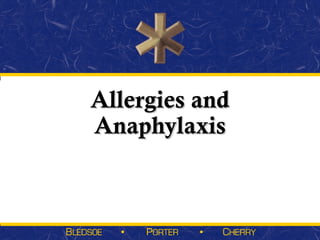
Anaphylaxis
- 2. Sections Pathophysiology Assessment Findings in Anaphylaxis Management of Anaphylaxis Assessment Findings in Allergic Reaction Management of Allergic Reactions Patient Education
- 3. Allergies and Anaphylaxis Allergic Reaction An exaggerated response by the immune system to a foreign substance Anaphylaxis An unusual or exaggerated allergic reaction A life-threatening emergency
- 4. Pathophysiology The Immune System Pathogens Toxins Cellular Immunity Humoral Immunity Antibodies (Immunoglobulins) • IgA, IgD, IgE, IgG, IgM
- 5. Pathophysiology Immune Response Exposure to antigen produces primary response with general antibodies. Immune system develops antigen-specific antibodies and memory. Future exposures generate a faster secondary response. Natural and Acquired Immunity Induced Active Immunity Active and Passive Immunity
- 6. Allergies Sensitization Hypersensitivity Delayed Results from cellular immunity and does not involve antibodies. Commonly results in skin rash. Results from exposure to certain drugs or chemicals. Immediate Exposure quickly results in secondary response. More severe than delayed hypersensitivity.
- 7. Allergies Allergen Exposure generates secondary response. Large quantities of IgE are released. Allergen binds to IgE, causing chemical release. • Release is “allergic reaction.” • Includes histamines, heparin, and other substances that are designed to minimize the body’s exposure to an antigen. • Histamine causes bronchoconstriction, vasodilation, increased gastric motility, and increased vascular permeability. • Angioneurotic edema.
- 8. Anaphylaxis Causes
- 9. Anaphylaxis Causes Injections Most anaphylaxis results from the injected route. Allergen rapidly distributed throughout the body, resulting in massive histamine release. • Parenteral penicillin injections and insect stings. • Affects cardiovascular, respiratory, gastrointestinal, and integumentary systems. • Significant plasma loss through increased vascular permeability. • Slow-reacting substance of anaphylaxis.
- 10. Assessment Findings in Anaphylaxis Focused History & Physical Exam Focused History SAMPLE & OPQRST History • Rapid onset, usually 30–60 seconds following exposure. • Speed of reaction is indicative of severity. • Previous allergies and reactions. Physical Exam Presence of severe respiratory difficulty is key to differentiating anaphylaxis from allergic reaction.
- 11. Assessment Findings in Anaphylaxis Physical Exam Facial or laryngeal edema Abnormal breath sounds Hives and urticaria Hyperactive bowel sounds Vital sign deterioration as the reaction progresses
- 12. Management of Anaphylaxis Scene Safety Consider the possibility of trauma. Protect the Airway. Use airway adjuncts with care. Intubate early in severe cases to prevent total occlusion of the airway. Be prepared to place a surgical airway.
- 13. Management of Anaphylaxis Support Breathing High-flow oxygen or assisted ventilation if indicated. Establish IV Access Patient may be volume-depleted due to “third spacing” of fluid. Administer crystalloid solution at appropriate rate. Place a second IV line if indicated.
- 14. Management of Anaphylaxis Administer Medications: Oxygen Epinephrine Antihistamines Corticosteroids Vasopressors Beta-agonists Other agents Psychological Support
- 15. Assessment Findings in Allergic Reaction
- 16. Management of Allergic Reactions Scene safety Protect the airway. Support breathing. Establish IV access. Administer medications: Antihistamines Epinephrine
- 17. Patient Education Prevention of Reactions Recognition of Signs/Symptoms Patient-initiated treatment Epinephrine auto-injectors Desensitization
- 18. Summary Pathophysiology Assessment Findings in Anaphylaxis Management of Anaphylaxis Assessment Findings in Allergic Reaction Management of Allergic Reactions Patient Education
Notas del editor
- Pathogen – a disease producing agent or invading substance that causes an immune response. Anitgen – any substance capable of producing an immune response. Including toxins released by bacteria. The body has 2 mschanisma to destroy and illiminate these antigens Cellular immunity – results from a direct attack by specialized cells of the immune system Humoral immunity – reults from the attack of antibodies (immunoglobins) IgA, Igd, IgE, IgM. Manufactured by B cells.
- Primary response – initial response to an antigen Secondary response – If the body is exposed a second time, antibodies specific to the antigen are released. Natural Immunity – present at birht Aquired immunity – developed over time resulting from an exposure Active immunity – aquired following exposeure, results in production of antibodies Induced active immunity – vacination Passive Immunity – administration of immunity Natural passive – placental barrier from mother to child Induced passive – tetanus
- Sensitization is the initial exposure of a person to an antigen that results in an immune response. Subsequent exposures result in a much stronger secondary response. Hypersensitivity or Allergy Delayed hypersensitivity – result of cellular immunity, days and hours following exposure, skin rash ie poison ivy Immediate hypersenitivity – ex hay fever, drug allergies, asthma,
- Allergen, a substance capable of inducing allergic reaction ie drugs, food, animals, insects, fungi molds IgE is released following exposure – IgE binds to basophil (special white blood cells) and mast cells (granulocytes), these cells release histamine and heparin , which are stored in granules, into the sourounding tissues. This process is called degranulation or allergic reaction. Histamine caues bronhoconstriction, vasodilation, increased vascular permeability, increased intestinal motility. Angioedema – swelling of hands and face and upper airway from increased vascular permeability. Histamine receptors (H1 and H2) – the goal of histamine response is to limit bodies exposure to antigens. Broncoconstriction reduses antigens entering resiratory track, vascular permiability removes antigens from circulatory system etc.
- epi – sympathetic agonist, causes increased heart rate inotropic peripheral vasoconstriction reverse bronchospasm reverse capilary permebility .3 to .5 1:1,000 subQ, .3 - .5 mg 1:10,000 IV, peds .01 mg/kg, antihistamines – benadryl non selective H1 H2 blocker 25 – 50 mg IV, zantac ex selective H2 used for ulcers but also effects vascular syst corticosteroids – of little benefit in the intial stages but help suppress the inflammatory response ie solu-medrol vasopressors – dopamine beta agonist – albuterol to reduce bronchospasm and laryngeal edema